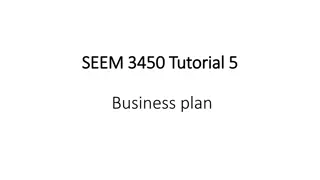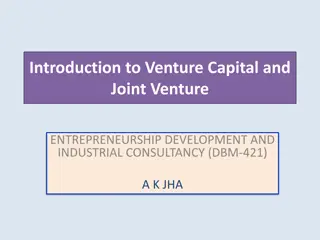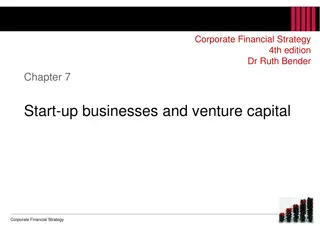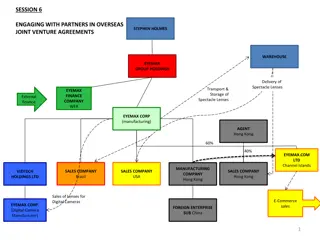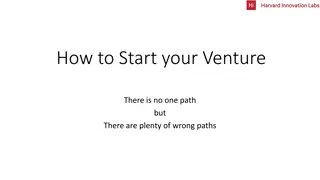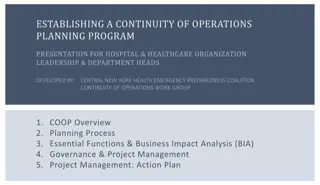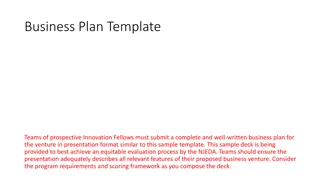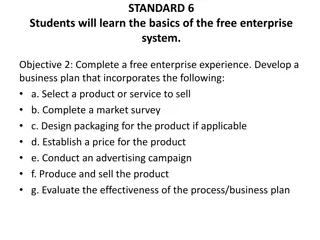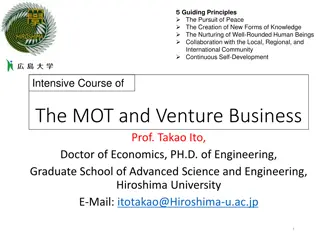Importance of Business Planning for a Successful Venture
Effective business planning is crucial for the success of any venture. Without a clear plan in place, the chances of failure increase significantly. By developing a comprehensive business plan, entrepreneurs can set themselves apart from the competition, attract investors, and navigate challenges successfully. Key elements such as vision statement, mission statement, and SWOT analysis are essential in creating a solid foundation for business growth and sustainability.
Download Presentation

Please find below an Image/Link to download the presentation.
The content on the website is provided AS IS for your information and personal use only. It may not be sold, licensed, or shared on other websites without obtaining consent from the author. Download presentation by click this link. If you encounter any issues during the download, it is possible that the publisher has removed the file from their server.
E N D
Presentation Transcript
Entrepreneurship The Importance of Business Planning for a Venture ELIB 203 Week 4
The Importance of Business Planning for a Venture A goal without a plan is just a wish
The Importance of Business Planning for a Venture When you decide on a brilliant business idea, the challenge is to provide a clear plan to get the idea executed. It requires more than one person and people with different skills to plan well. You can start writing your business plan (or drafts of it) while planning.
The Importance of Business Planning for a Venture From each ten new startups, only one survives within the first two years (the rest fail to continue or go bankrupt).. If you start your business with no clear plan, you do not know the future of your business.
The Importance of Business Planning for a Venture You can set yourself aside from competition and gain a competitive advantage by planning well. The business plan documents the plan your team is achieving.
How to Set a Good Plan for My Business? Creating a business plan may seem boring, but you should not neglect it. This is the plan that will guide your company and attract investors!
How to Start Planning? Gather and provide documentation about your business Every member in the organization should contribute to, read, and understand these documents
The Documentation you need Vision statement Mission statement SWOT analysis
What is SWOT analysis S.W.O.T. is an acronym that stands for Strengths, Weaknesses, Opportunities, and Threats. A SWOT analysis is an organized list of your business s greatest strengths, weaknesses, opportunities, and threats. (See End of Class activity about SWOT analysis)
What is SWOT analysis Strengths and weaknesses are internal to the company (such as reputation, patents, employees experience, location). You can change them over time Opportunities and threats are external (suppliers, competitors, current prices of raw materials); they are out there in the market and you cannot change them
SWOT Analysis S objectives W achieve its objectives T Weaknesses Internal limitations that may interfere with a company s ability to Strengths Internal capabilities that may help a company reach its Internal Positive Negative O Threats Opportunities External factors that the company may be able to exploit to its advantage Current and emerging external factors that may challenge the company s performance External
Example of SWOT Analysis Strengths Weaknesses Internal Factors Technological skills Leading brands Distribution channels Customer loyalty/relationship Production quality Scale Management Absence of important skills Week brands Poor access to distribution Low customer retention Unreliable product/service Sub-scale Management Opportunities Threats External Factors Changing customer base Closing of geographic markets Technological advances Changes in government politics Tax increases Change in population age New distribution channels Changing customer tastes Technological advances Changes in government politics Lower personal taxes Change in population age New distribution channels
Example of SWOT Analysis Strengths Weaknesses Your specialist marketing expertise. A new, innovative product or service. Location of your business. Quality processes and procedures. Any other aspect of your business that adds value to your product or service. Lack of marketing expertise. Undifferentiated products or services (i.e. in relation to your competitors). Location of your business. Poor quality goods or services. Damaged reputation. Internal Opportunities Threats A developing market such as the internet. Mergers, joint ventures or strategic alliances. Moving into new market segments that offer improved profits. A new international market. A market vacated by an ineffective competitor. A new competitor in your home market. Price wars with competitors. A competitor has a new, innovative product or service. Competitors have superior access to channels of distribution. Taxation is introduced on your product or service. External
Example of SWOT Analysis Strengths Weaknesses Experience: our execs have decades of experiences with plastics, engineering, and successful startups. Relationships: The company has excellent relationships with firms that collect and distribute PET bottles. Location: There are no other PET recycler than continue to export to China. High startup costs: The very high costs of opining a PET plant will require both investments and loans. Construction time: The recycling and extrusion facility must be built before we can begin processing plastic. Internal Opportunities Threats Environmental protection standards: Whenever the government regulations are updated, we need to develop technically and economically feasible recycling solutions that meet the standards. Material scarcity: Our business model is PET-dependent. If use of PET bottles declines or becomes obsolete, we will lose our supply. Major facility expansion: The initial PET recycling facility will have a capacity of 46 million pounds, but the current annual stock of recyclable bottle material in California, Oregon and Washington is more than200 million pounds. External R & D: Potential for other uses of PET- recycling by-product.
What Should Be Included in a Business Plan? Executive summary Market analysis Company description Product Financial
How to Draft a Business Plan Focus on your niche Use clear language Rewrite frequently Activity: Refer to the Writing a Business Plan: The Basics document in the handouts on pages 2 to 4.
Group Activity In a team, select an industry and a company within this industry; then provide a SWOT analysis Refer and use the sheet of SWOT analysis in the (Business Modelling Workbook) document in the handouts. Two teams will be asked to explain their analysis to the class at the end of session
















